Samsung Galaxy Tab Pro 8.4 and 10.1 Review
by Jarred Walton on March 22, 2014 9:30 PM ESTPerformance Benchmarks
In the world of laptops where I come from, we’re fast reaching the point – if not well beyond it – where talking about raw performance only matters to a small subset of users. Everything with Core i3 and above is generally “fast enough” that users don’t really notice or care. For tablets, the difference in speed between a budget and a premium device is far more dramatic. I’ve included numbers from the Dell Venue 8, which I’ll be providing a short review of in the near future. While the price isn’t bad, the two Samsung tablets feel substantially snappier – as they should. We’ll start with the CPU/system benchmarks and then move to the GPU/Graphics tests.
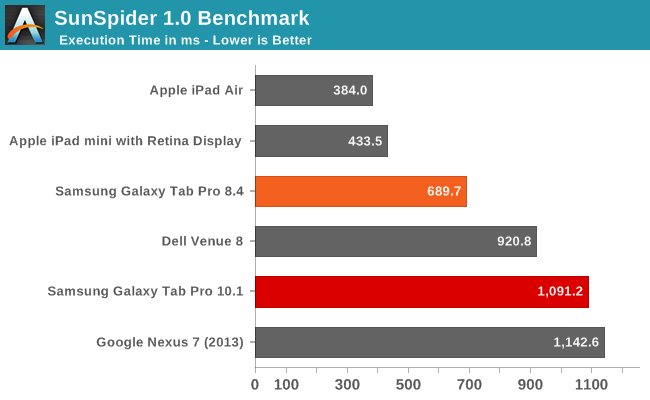
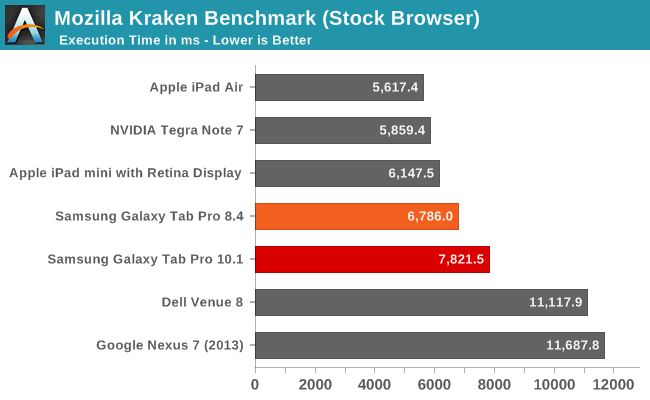
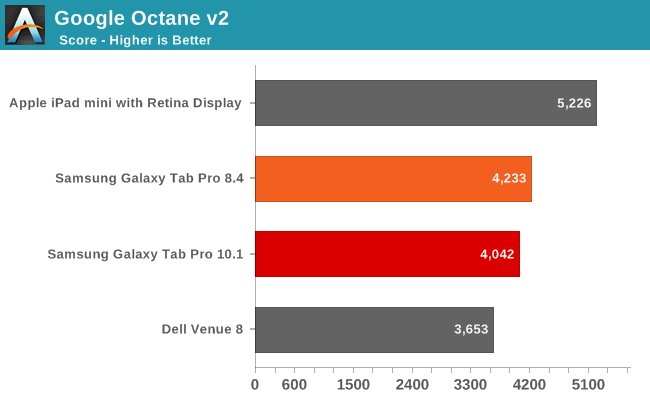

In terms of CPU speed, the Apple A7 chips still take the lead in all of our tests, though not always by a large margin. We’re also using different browsers (Chrome vs. Safari), and JavaScript benchmarks aren’t always the greatest way of comparing CPU performance. I ran additional benchmarks on the two Samsung tablets just to see if I could get some additional information; you can find a table of results for AndeBench, Basemark OS II, and Geekbench 3.
| CPU/System Benchmarks of Samsung Galaxy Tab Pro | |||
| Benchmark | Subtest | Tab Pro 10.1 | Tab Pro 8.4 |
| Andebench | Native | 13804 | 17533 |
| Java | 708 | 790 | |
| Basemark OS II | Overall | 865 | 1062 |
| System | 1542 | 1529 | |
| Memory | 419 | 503 | |
| Graphics | 1032 | 2555 | |
| Web | 838 | 724 | |
| Geekbench 3 | Single | 942 | 910 |
| Multi | 2692 | 2847 | |
| Integer Single | 1028 | 967 | |
| Integer Multi | 3135 | 3343 | |
| FP Single | 897 | 848 | |
| FP Multi | 3106 | 3080 | |
| Memory Single | 860 | 922 | |
| Memory Multi | 982 | 1391 | |
Interestingly, the Samsung Exynos 5 Octa 5420 just seems to come up short versus the Snapdragon 800 in most of these tests. However, there’s a bit more going on than you might expect. We checked for cheating in the benchmarks, and found no evidence that either of these tablets was doing anything unusual in terms of boosting clock speeds. What we did find is that the Pro 10.1 is frequently not running at maximum frequency – or anywhere near it – in quite a few of our CPU tests.
Specifically, Sunspider, Kraken, and Andebench had the cores hitting a maximum 1.1-1.3GHz. The Pro 8.4 meanwhile would typically hit the maximum 2.3GHz clock speed. The result, as you might imagine, is that the 8.4 ends up being faster, sometimes by a sizeable margin. Basemark OS II, Geekbench 3, and AnTuTu on the other hand didn’t have any such odd behavior, with the Pro 10.1 often hitting 1.8-1.9GHz (on one or more cores) during the testing, and when that happens it often ends up slightly faster than the Pro 8.4.
Which benchmark results are more "valid"? Well, that's a different subject, but as we're comparing Samsung tablets running more or less the same build of Android, we can reasonably compare the two and say that the 8.4 has better overall performance. Updated drivers or tweaking of the power governor on the 10.1 might change things down the road, but we can only test what exists right now.
Overall, both systems are sufficiently fast for a modern premium tablet, so I wouldn’t worry too much about whether or not you’re getting maximum clock speeds in a few benchmarks – in normal use you likely won’t notice one way or the other. But we’re only talking about the CPU performance when we say you won’t see the difference; let’s move over to the graphics benchmarks to see how the Galaxy Pro tablets fare.
Graphics Performance
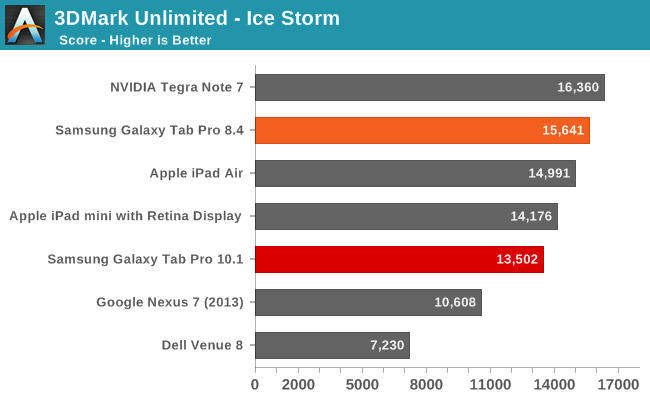
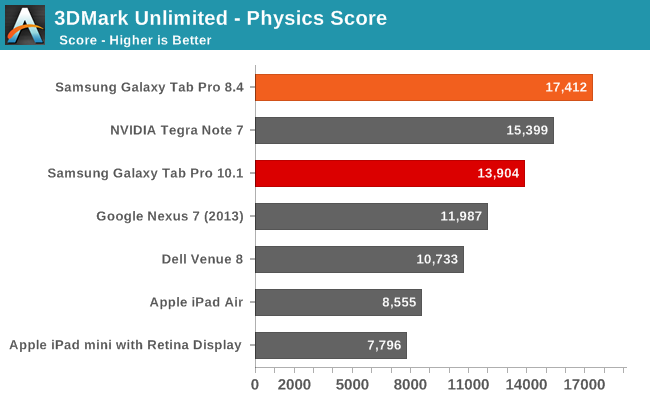
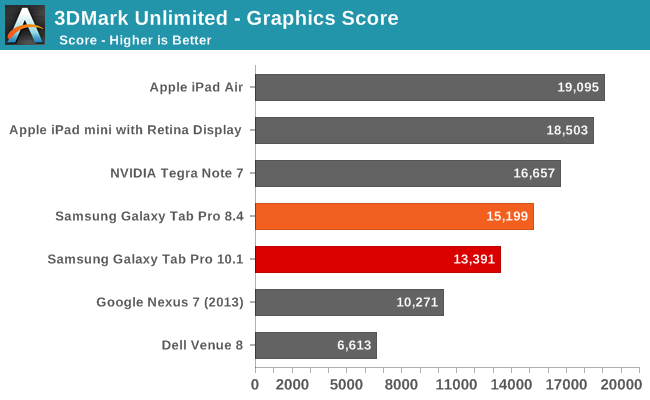
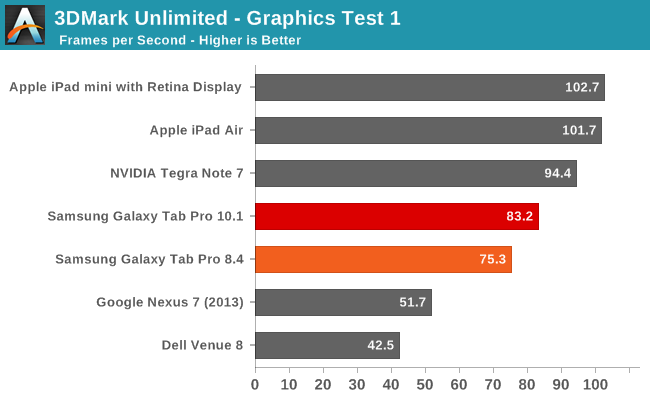
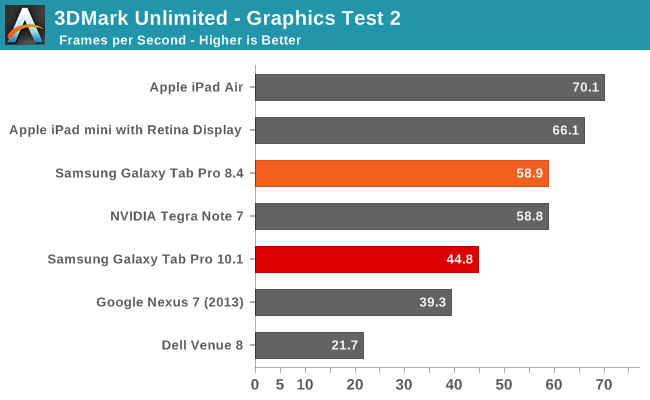
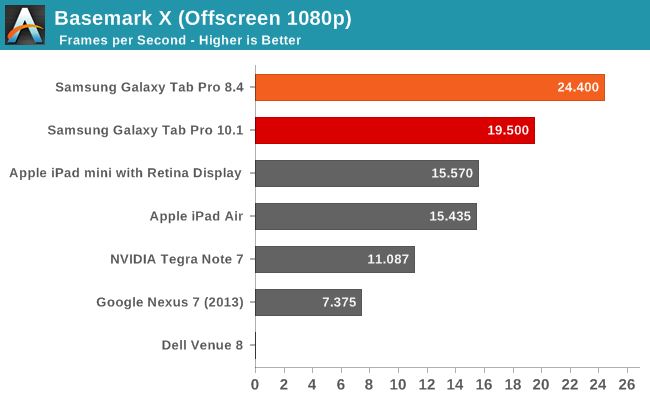
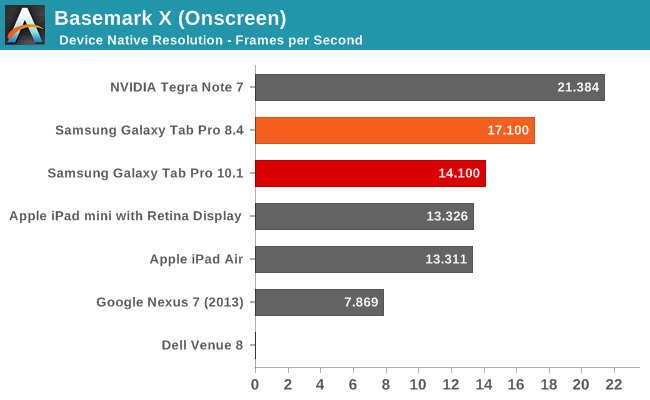
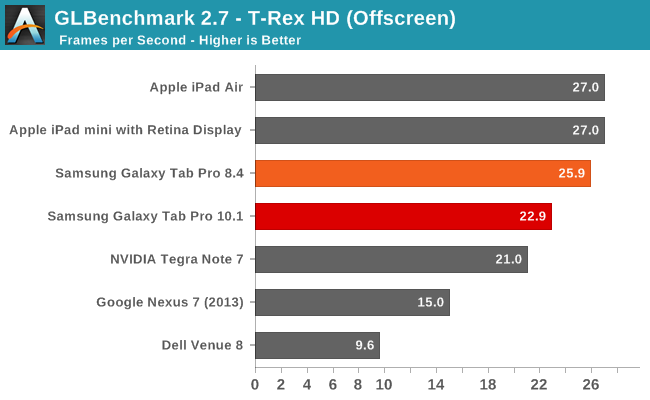
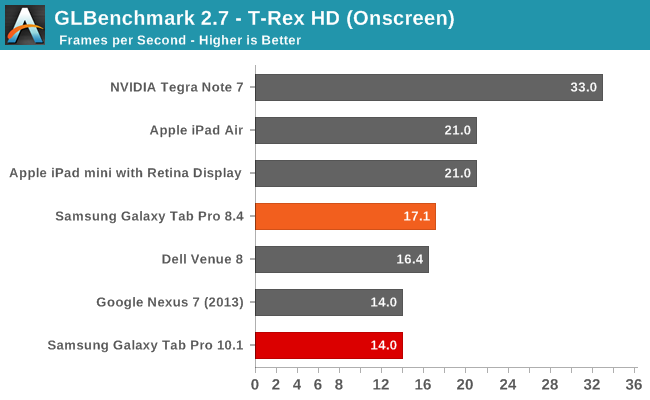
Outside of the 3DMark Unlimited Graphics Test 1 result, the Pro 8.4 sweeps the tables against its big brother. Playing games like Angry Birds Go! or any other reasonably demanding 3D titles in my experience confirms the above results – Adreno 330 beats the Mali-T628; end of discussion. I also had a few quirks crop up with the Pro 10.1 graphics, like Plants vs. Zombies 2 at one point stopped rendering all the fonts properly; a reboot fixed the problem, but I may have seen one or two other rendering glitches during testing. I have some additional results for GPU testing as well via GFXBench 3.0 if you’re interested:
| Graphics Benchmarks of Samsung Galaxy Tab Pro | |||
| Benchmark | Subtest | Tab Pro 10.1 | Tab Pro 8.4 |
| GFXBench 3.0 Onscreen | Manhattan (FPS) | 2.9 | 5.8 |
| T-Rex (FPS) | 14 | 17.1 | |
| ALU (FPS) | 13 | 59.8 | |
| Alpha Blending (MB/s) | 3295 | 6847 | |
| Fill (MTex/s) | 1956 | 3926 | |
| GFXBench 3.0 Offscreen | Manhattan (FPS) | 5.5 | 10.8 |
| T-Rex (FPS) | 22.9 | 25.9 | |
| ALU (FPS) | 25.6 | 138 | |
| Alpha Blending (MB/s) | 3093 | 7263 | |
| Fill (MTex/s) | 1956 | 3780 | |
The new Manhattan benchmark was one of the other tests where the Pro 10.1 didn’t seem to render things properly, and even then the Pro 8.4 ends up with nearly twice the frame rates. The ALU, Alpha Blending, and Fill rate scores might explain some of what’s going on, where in some cases the Pro 8.4 is more than four times as fast. Regardless, if you want maximum frame rates, I’d suggest getting the Pro 8.4 over the 10.1.










125 Comments
View All Comments
JarredWalton - Sunday, March 23, 2014 - link
I lack the hardware to properly see whether this is Pentile or not... I hope to have the necessary tools "soon". As I noted, the pixels on these are so small that I'm not sure the arrangement really matters. I can literally press my nose against the tablets and I still couldn't say with certainty whether they're RGB stripe or Pentile. If I need a microscope to say what type of arrangement they use, does it really matter in the real world?themossie - Sunday, March 23, 2014 - link
Jarred,If you need a microscope to tell the difference it doesn't matter in the real world :-) That may not be true for everyone.
My problem with Pentile is that lines looked blurry and caused eyestrain (headaches after a few minutes of use) because vertical/horizontal lines weren't 'straight' without RGB striping. This can be somewhat mitigated by different subpixel arrangements, but doesn't go away entirely. If these are pentile, this would probably be an issue for me at this resolution and screensize.
This problem is somewhat explained in the second paragraph of http://www.anandtech.com/show/7743/the-pixel-densi... -
"For example, human vision systems are able to determine whether two lines are aligned extremely well, with a resolution around two arcseconds. This translates into an effective 1800 PPD. For reference, a 5” display with a 2560x1440 resolution would only have 123 PPD."
themossie - Sunday, March 23, 2014 - link
*If you need a microscope to tell the difference, it doesn't matter for you :-Pakdj - Monday, March 24, 2014 - link
But it does for you? WTF are you doing with your tablet to need a microscope to see the 'pixel arrangement'? Other than 'fatigue'....if that's real or not, up for debate, these HiDPI displays are beyond the point of 'mattering' to anyone other than the most anal of display dorksthemossie - Monday, March 24, 2014 - link
Huh? I don't care about high resolution (or high DPI), I just want RGB stripe so I don't get headaches :-Pdarkich - Tuesday, March 25, 2014 - link
Your argument seems incredibly ridiculous.By your definition we would need like 32K resolutions on a 5" screen for our vision to stop being bothered by pen tile!!
I could bet a house that your headache isn't caused by freaking micro missalingment of lines on a 380ppi screen.
I use my Note 3 for hours at a time and wow, I don't have headaches. It must be a natural phenomenon!
How about you try things like lowering the brightness?? Lol.
Get reasonable, man
StrangerGuy - Tuesday, March 25, 2014 - link
Right, so after gutting 1/3 effective PPI with pentile, how much would these Note Pros left? 9000 or number so high it doesn't matter like the Note 3 ? Nope, a measly 200 for the 10.1 and an absymal 150 for the 12.2. And we thought the first iPhone was bad at 160 by current standards, and now we don't even get AMOLED at all as a tradeoff for pentile?Hey let's just give a free pass Samsung on gutting the most important aspect of mobile device, why the hell not? The Android PPI flip-floppers are funny: "lol Apple still stuck at 300 ppi" but "150 ppi on uber expensive 12.2 Pro? It doesn't matter because I can't see it"
darkich - Tuesday, March 25, 2014 - link
Well sorry but that's crazy.The Note 8.4 has 360ppi and I can assure you the sharpness looks exactly the same as on the LCD with the similar ppi.
End of discussion.
As for the note 12.2..comparing it with the forst iPhone shows no one should take you seriously.
Do you have a laptop, or desktop?
If so, tell me their respective pixel densities
ESC2000 - Friday, March 28, 2014 - link
Yes it matters to the people who use ipads and will never consider buying this tablet who are trying to avoid the cognitive dissonance of having bought an equally or more expensive device with fewer features. And possibly to one guy who gets headaches from penile.davidgoscinny - Sunday, March 23, 2014 - link
I hope they've worked on the Flipboard app team to develop this Magazine UX "hence keeping the Flipboard) otherwise they should've at least changed the name.